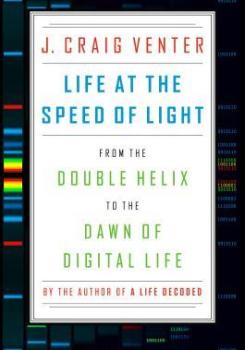DNA, the Software of Life
An excerpt from “Life at the Speed of Life.”
The following is an excerpt from Life at the Speed of Light: From the Double Helix to the Dawn of Digital Life, by J. Craig Venter.
Half a century ago the great evolutionary geneticist Motoo Kimura estimated that the amount of genetic information has increased by one hundred million bits over the past five hundred million years. The DNA code-script has come to dominate biological science, so much so that biology in the twenty-first century has become an information science. Sydney Brenner, the Nobel Prize–winning South African biologist, remarked that the code-script “must form the kernel of biological theory.” Taxonomists now use DNA bar codes to help distinguish one species from another. Others have started to use DNA in computation, or as a means to store information. I have led efforts not only to read the digital code of life but also to write it, to simulate it within a computer, and even to rewrite it to form new living cells.
On July 12, 2012, almost seven decades after Schrödinger’s original lectures, I found myself in Dublin, at the invitation of Trinity College. I was asked to return to Schrödinger’s great theme and attempt to provide new insights and answers to the profound question of defining life, based on modern science. Everyone is still interested in the answer, for obvious reasons, and I have very personal ones, too. As a young corpsman in Vietnam, I had learned to my amazement that the difference between the animate and inanimate can be subtle: a tiny piece of tissue can distinguish a living, breathing person from a corpse; even with good medical care, survival could depend in part on the patient’s positive thinking, on remaining upbeat and optimistic, proving a higher complexity can derive from combinations of living cells.
At 7:30 on a Thursday evening, with the benefit of decades of progress in molecular biology, I walked up to the same stage on which Schrödinger appeared, and like him appearing before the Taoiseach, in what was now the Examination Hall of Trinity College, a matchless backdrop. Under a vast chandelier, and before portraits of the likes of William Molyneux and Jonathan Swift, I gazed into an audience of four hundred upturned faces and the bright lights of cameras of every kind and description. Unlike Schrödinger’s lectures, I knew my own would be recorded, live-streamed, blogged, and tweeted about as I once again tackled the question that my predecessor had done so much to answer.
Over the next sixty minutes I explained how life ultimately consists of DNA-driven biological machines. All living cells run on DNA software, which directs hundreds to thousands of protein robots. We have been digitizing life for decades, since we first figured out how to read the software of life by sequencing DNA. Now we can go in the other direction by starting with computerized digital code, designing a new form of life, chemically synthesizing its DNA, and then booting it up to produce the actual organism. And because the information is now digital we can send it anywhere at the speed of light and re-create the DNA and life at the other end. Sitting next to Taoiseach Enda Kenny was my old self-proclaimed rival, James Watson. After I had finished, he climbed onto the stage, shook my hand, and graciously congratulated me on “a very beautiful lecture.”

Life at the Speed of Light, which is based in part on my Trinity College lecture, is intended to describe the incredible progress that we have made. In the span of a single lifetime, we have advanced from Schrödinger’s “aperiodic crystal” to an understanding of the genetic code to the proof, through construction of a synthetic chromosome and hence a synthetic cell, that DNA is the software of life. This endeavor builds on tremendous advances over the last half-century, made by a range of extraordinarily gifted individuals in laboratories throughout the world. I will provide an overview of these developments in molecular and synthetic biology, in part to pay tribute to this epic enterprise, in part to acknowledge the contributions made by key leading scientists. My aim is not to offer a comprehensive history of synthetic biology but to shed a little light on the power of that extraordinarily cooperative venture we call science.
DNA, as digitized information, is not only accumulating in computer databases but can now be transmitted as an electromagnetic wave at or near the speed of light, via a biological teleporter, to recreate proteins, viruses, and living cells at a remote location, perhaps changing forever how we view life. With this new understanding of life, and the recent advances in our ability to manipulate it, the door cracks open to reveal exciting new possibilities. As the Industrial Age is drawing to a close, we are witnessing the dawn of an era of biological design. Humankind is about to enter a new phase of evolution.
From Life at the Speed of Light: From the Double Helix to the Dawn of Digital Life, by J. Craig Venter. Reprinted by arrangement with Viking, a member of Penguin Group (USA) LLC, A Penguin Random House Company. Copyright © J. Craig Venter, 2013.
J. Craig Venter is author of Life at the Speed of Light: From the Double Helix to the Dawn of Digital Life (Viking, 2013); founder, chairman and CEO of the J. Craig Venter Institute; and founder and CEO of Synthetic Genomics Inc. in La Jolla, California.